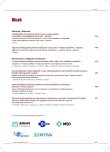Comparison of various methods of body fat analysis in overweight and obese women
Authors:
R. Větrovská 1; Z. Lačňák 2; D. Haluzíková 2; P. Fábin 1; P. Hájek 3; L. Horák 3; M. Haluzík 1; Š. Svačina 1; M. Matoulek 1
Authors‘ workplace:
III. interní klinika 1. lékařské fakulty UK a VFN Praha, přednosta prof. MUDr. Štěpán Svačina, DrSc., MBA
1; Ústav tělovýchovného lékařství 1. lékařské fakulty UK a VFN Praha, přednosta doc. MUDr. Zdeněk Vilikus, CSc.
2; VŠ TJ MEDICINA Praha, vedoucí lékař MUDr. Martin Matoulek, Ph. D.
3
Published in:
Vnitř Lék 2009; 55(5): 455-461
Category:
Original Contributions
Overview
Introduction:
Body composition assessment and determination of the amount and distribution of body fat, respectively, form an essential part of the basic clinical assessment of an obese patient. However, there are no recommended methods to determine the amount of fat in obese population.
The aim of our study was to compare the methods most frequently used to determine the amount of body fat in overweight and obese women in clinical practice (multi‑frequency bio-electrical impedance analysis– BIA using the Bodystat, Omron and Tanita machines and the skinfold test using acalliper) with areference method (DEXA). The study further aimed to compile prediction formulae enabling clinicians to calculate the percentage of body fat when using the available body fat measurement techniques.
Methods:
The study included 61overweight and obese women (mean age 48.6years±13.9years). Four practice‑based body fat assessment methods were used– bioimpedance technique with tetra-polar electrode arrangement (Bodystat machine), bioimpedance technique with bi-pedal electrode arrangement (Tanita machine), hand-held bioimpedance technique (Omron machine) and the anthropometry assessment– the skinfold calliper technique. These methods were compared to the method considered as the reference– the whole body densinometry (DEXA).
Results:
The results obtained using the listed body fat assessment methods suggest that the resulting body fat measurements differ importantly depending on the method used. The highest correlation with DEXA was found for the Bodystat BIA (r=0.9096, p<0.001). Prediction formulae were constructed for amore accurate calculation of body fat content when using the techniques evaluated in the present study.
Conclusion:
When the newly compiled formulae are employed, the body fat assessment obtained with any of the methods applied in the present study will approximate DEXA. The BIA techniques were found to be particularly precise. Therefore, further evaluation of these techniques is recommendable to support their use as methods for monitoring the efficacy of weight reduction programmes in overweight and obese patients.
Key words:
obesity– overweight– body composition– DEXA– bioimpedance– prediction equations
Sources
1. Hainer V. Základy klinické obezitologie. Praha: Grada Publishing 2004.
2. WHO Consultation. Obesity: preventing and managing the global epidemic. Ženeva: WHO 2000.
3. Všetulová E, Bunc V. Využití bioimpedanční metody pro stanovení procenta tělesného tuku obézních žen. Čas Lék Čes 2004; 143: 528–531.
4. Pařízková J. Složení těla, metody měření a využití ve výzkumu a lékařské praxi. Med Sport Boh Slov 1998; 7: 1–6.
5. Vilikus Z, Brandejský P, Novotný V. Tělovýchovné lékařství. Praha: Karolinum 2004.
6. Dlouhá R, Heller J, Bunc V et al. Srovnání rovnic Pařízkové pro zjišťování tělesného tuku sportujících žen. Med Sport Boh Slov 1998; 7: 1–6.
7. Pařízková J. Složení těla a lipidový metabolismus za různého pohybového režimu. Praha: Avicenum 1973.
8. Heyward VH, Stolarczyk LM. Applied body composition assessment. Champaign: Human kinetics 1996.
9. Kinkorová I. Využitelnost současných metod pro stanovení tělesného složení v terénních a laboratorních podmínkách. Disertační práce. UK FTVS Praha 2004.
10. Pařízková J, Hainer V, Kunešová M et al. Zkušenosti s vyšetřováním tělesného složení normálních a obézních osob u nás a v zahraničí. Med Sport Boh Slov 1998; 3: 103.
11. Hainer V, Kunešová M, Pařízková J et al. Stanovení tělesného složení: Srovnání bipedální BIA s hydrodenzitometrií a antropometrií. Čes Slov Gastroenterologie 1996; 2: A6–A7.
12. Bláha P, Mottl P, Zamrazilová H. Vhodnost stanovení množství tuku používanými metodami u obézních. [on-line] [cit. 2006-6-18]. Dostupné z: http://www.obesitas.cz/download/obezitologie2005Luhacovice.pdf.
13. Bláha P, Brabec M, Šrámková D et al. Porovnání metod klasické antropometrie stanovení tělesného složení obézních dětí s moderní metodou DEXA. [on-line] [cit. 2006-6-18]. Dostupné z:http://www.obesitas.cz/download/ obezitologie2002.pdf.
14. Maud PJ, Foster C. Physiological Assessment of Human Fitness. Champaign: Human Kinetics 1995.
15. Deurenberg P. Limitations of the bioelectrical impedance method for the assessment of body fat in severe obesity. Am J Clin Nutr 1996; 64 (Suppl 3): 449S–452S.
16. Pařízková J. Body fat and physical fitness. The Hague: Martinus Nijhoff 1977.
17. Hendl J. Přehled statistických metod zpracování dat: analýza a metaanalýza dat. Praha: Portál 2006.
18. Minderico CS, Silva AM, Keller K et al. Usefulness of different techniques for measuring body composition changes during weight loss in overweight and obese women. Br J Nutr 2008; 99: 432–441.
19. Thomson R, Brinkworth GD, Buckley JD et al. Good agreement between bioelectrical impedance and dual-energy X‑ray absorptiometry for estimating changes in body composition during weight loss in overweight young women. Clin Nutr 2007; 26: 771–777.
Labels
Diabetology Endocrinology Internal medicineArticle was published in
Internal Medicine

2009 Issue 5
Most read in this issue
- Extrinsic allergic alveolitis – rarely diagnoticated disease
- Turner’s syndrome requires multidisciplinary approach
- Comparison of various methods of body fat analysis in overweight and obese women
- Turner syndrome is associated with increased cardiovascular morbidity and mortality
